Day 01 Arrive Bagdogra to Thimphu via Phuntsholing.
After arriving you will be welcomed by our tour representative in Bagdogra who will be your tour guide during your entire trip in Bhutan. After lunch you will be heading to Phuntsholing Bhutan which is almost 157.4kms (3hours 5o minutes). Upon reaching Phuntsholing( before 12 pm) the permit formalities will be done and drive towards Thimphu (Capital of Bhutan) (2500m 160 kms 04-05 hours). On the way we will visit the famous Kharbandi Gompa(Temple),from where we will have the scenic view of the plains of India. We will pass numerous small town of Gedu, Chuka and Chunzum, the confluence of Pa Chu and Thin Chu. Continue the drive to reach the Capital.
Check into your hotel in Thimphu.
Day 02: Thimphu
After breakfast we will visit following places Thimphu, the capital of Bhutan.
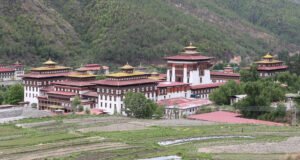
Tashichho Dzong, aBuddhist monastery cum fortress at the northern edge of Thimpu the capital city of Bhutan. The original Thimphu Dzong (the Dho-Ngyen Dzong) is said to have been constructed in 1216 by Lama Gyalwa Lhanangpa.
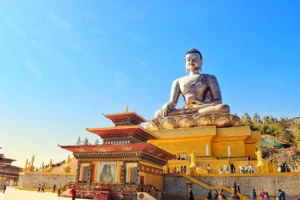
Kuensel Phodrang
The Kuensel Phodrang or the Buddha point is the world’s largest sitting Buddha statue, the statue is 167 feet high.
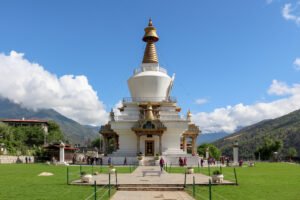
The National Memorial was built by Bhutan’s third king, H.M. Jigme Dorji Wangchuck who is also known as the “father of modern Bhutan.” The national Memorial Chorten is located in the center of the capital
city, Thimphu and is designed like a Tibetan style Chorten.
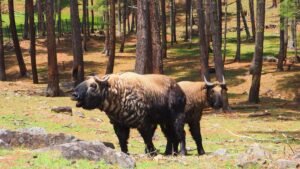
Motithang Takin Preserve
The Motithang Takin Preserve also known as the Thimphu Zoo by many is a small natural preserve for the Takin Bhutan’s national animal.
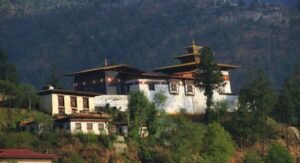
Changangkha lhakhang
The Chagangkha Lhakahng temple is a early medieval Buddhist temple in the capital city Thimphu. The temple is situated on a ridge overlooking the city, near Mothitang on the outskirts of Thimphu. The temple is the oldest temple in Thimphu and was constructed by Lama Phajo Drukgom Zhigpo in the 12 century AD. Lama Phajo Drukgom Zhigpo is also the founder of the Drukpa Kaygo School of Buddhism. The Lhakhang’s central deity is Chenirizig. There is a large statue of
Chenrizig, the 11 headed, thousand arm manifestation of Avolokiteshwara. The prayer books in the temple are larger in size compared to the usual Buddhist texts. There are also large prayer wheels and paintings in the walls of the temple.
The temple offers an excellent view of the city of Thimphu from its courtyard.
Over Night in Thimphu Hotel.
Day 03: Thimphu – Punakha – Paro
After Early Breakfast we will drive towards Punakha via Dochula pass. We will stop over for tea at Dochula (3,100 m), where on a sunny day; you can get stunning views of the Himalayan ranges. The Dochu La Pass is probably the best known mountain pass in Bhutan. Located at an altitude of 3150 meter above sea level, the Dochu La Pass is about 30 kilometer away from the capital city Thimphu and the road to Punakha.
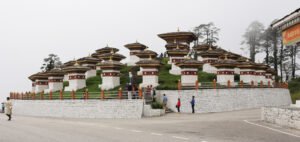
On a clear day the pass offers visitors a spectacular view of the majestic eastern Himalayan Ranges. A cup of hot coffee or tea at the pass has almost become part of tradition for people travelling to and fro from Punakha to the capital city.
There is a small cafeteria at the pass that offers a chance for travelers to enjoy a hot beverage or a snack, it is located just off the road and overlooks the pass and is an ideal place to sit back, relax and enjoy the
view. Another striking feature at the pass is the 108 Druk Wangyal Khangzang Chortens, that were built for the well-being of all sentiment beings on earth. The 108 Chorten were built as a tribute to the Kings of
Bhutan for their selfless service and leadership they offer to the people of Bhutan. These Stupas or Chortens also represent the peoples love, appreciation and loyalty towards the country’s King.
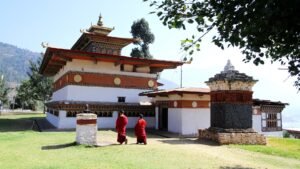
Chimi Lhakhang
The Chimi Lhakang or the Chimel Lhakang is a Buddhist monastery located in the Punakha District of Bhutan. The monastery stands on a small hill close to the village of Lobesa and was constructed in 1499 by Ngawang Choegyel, the 14thDrukpaheirarch. The Temple is very deeply connected to the legends of Saint Drukpa Kinley also known as the Devine Madman. It has been said that the demon of Dochu-La with a magic thunderbolt of wisdom in imprisoned him in a rock close to the temple. Drukpa Kuenley is called the Divine Madman due to his unorthodox methods of teaching via songs, humor and sometimes bizarre and shocking behavior with deep sexual overtones. You might be shocked to see that the temple houses a number of wooden phalluses that the Lama had brought with him from Tibet. Pilgrims who visit the monastery receive the blessing by being struck on the head with a ten inch wooden Phallus (erect penis). The symbol of an erect penis is said to ward off evil.
The monastery is also known as the temple of fertility and is visited not only by the Bhutanese but women from countries as far as Japan and United States to receive a special blessing that can help these women conceive children. These women receive the blessing by getting struck on the head with a 10 inch wooden/ ivory phallus.
The Temple can be accessed by undertaking a short 20 minute walk across the rice fields from the nearest road head. The Lhakhang is a square shaped building with a golden spire on its roof. The temple has many rows of prayer wheels and the temples exterior has embedded slate carvings of various Buddhist saints. Near the temples entrance there is a small Chorten that marks the spot where the Lama subdued the demon of Dochu La.

Punakha Dzong
The Punakha Dzong or the Pungtang Dechen Phortang Dzong is located at the confluence of the Mo Chhu and the Po Chhu River, combine to form the Puna Tsang Chu which in turn is a tributary of the mighty Brahmaputra River. The Dzong was constructed by Sahbdrung Ngwang Namgyal Wangchuck in 1638 on the exact spot as prophesized by the Guru Rinpoche some 800 years ago. According to the prophecy of Guru Rinpoche “a person named Namgyal will arrive at a hill that looks like an elephant”. And lo behold! Shabdung Ngawang Namgyal found that the peak of the hill was in the shape of an elephant’s trunk and built the Dzong at that very spot. Another legend associated with the Dzong is that of Zowe Palep, the architect of the Dzong received vision of the Dzong in his sleep. This vision got imprinted in the architects mind and enabled him to construct the Dzong without putting his plans to paper.
The Punakha Dzong is the second largest and the second oldest Dzong in Bhutan. The Dzong is home to some of the most sacred relics of the Drukpa Kagyu School of Buddhism; it is also home to the sacred mortal remains of Shabdrung Nagawang Namgyal and Trenton Pema Lingpa the great treasure discoverer of Bhutan. The Punakha Dzong has also served as the capital of Bhutan till 1955 before the capital was moved to Thimphu. The Dzong is still the winter residence of the Je Khenpo (chief abbot) and the central monastic body. The Punakha Dzong plays host to the annual Punakha Tshechu Festival which is very popular with the locals and tourists alike. After above signtseeing will drive towards Paro by evening.
Check in Paro Hotel.
Day 04: Paro Tiger’s Nest Hike.
After early morning breakfast we will take you for a morning hike up to Taktsang Monastery, also known as ‘Tiger’s Nest’. Hanging precariously and magically from a rather steep cliff, the Taktshang monastery is a monument of genuine pride for the Bhutanese nation.

It defies architectural principles to the core and amazes tourists from around the world. It is a sight to behold.
Kyichu Lhakhang
The Jowo Temple of Kyichu is one of the oldest temples in Bhutan. The temple was built by the Tibetan King Songsten Gampo in the 7th Century AD. Overnight in Paro Hotel.
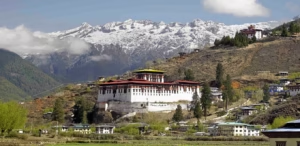
Rimpung Dzong
The Paro Dzong is probably Bhutan’s best known and most iconic Dzong. This is probably the first building you will notice when you land at Paro International Airport and will probably be your first memory of
Bhutan. The imposing Dzong is perhaps the finest example of Dzong architecture existing the world today, the massive buttered walls of the fortress dominates over the valley. The Rinpung Dzong’s names translate to the “Fortress on a heap of Jewels “.
The fortress was constructed in 1644 by Zhabdrung Ngawang Namgyal on the foundations of an ancient monastery. The approach toward the Dzong is through a traditional covered bridge called the Nemi Zam. A paved stone path runs alongside the imposing outer walls of the structure. The valley’s annual springtime religious festival called the Paro Tsechu is organized each year in the courtyard of the dzong and is attended by tourists from all over the world.

Ta Dzong (National Museum of Bhutan)
The National Museum of Bhutan is housed inside the six storied circular Ta Dzong. The Ta Dzong is a medieval watch tower situated above the Rimpung Dzong. The Ta Dzong was constructed in 1656 with a purpose to give advance warning to the Paro Dzong in case of an approaching army, in fact the word Ta means ‘to see’ in Dzongkha.
The future first king was imprisoned here for a brief period in 1872. In 1968 the Ta Dzong was converted into the National Museum of Bhutan. The Museum houses a priceless collection of textile, costumes, paintings, appliqué, wooden handicrafts, weapons, amour and jewelry. There is a small section dedicated to the natural history of Bhutan. There is a small chapel on the top of the building with icons
representing Himalayan Buddhist traditions. Later in the evening you will visit local market and then overnight in a hotel in Paro.
Day 05: Departure Paro to NJP via Phuntsholing.
In the morning after early breakfast we will head toward NJP via Phuntsholing for your onward destinations.
